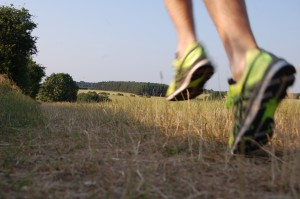Plantar Fasciitis: From the Podiatrist’s Foot
Plantar fasciitis is a painful foot condition that affects many thousands of people each year.…
One of the many great reasons to run lies in its simplicity and lack of need for complicated equipment. However there are items that will make running safer and more enjoyable if chosen with care. Each run is different, so carefully consider your requirements -and those of the run- before setting out.
Shoes
 A well-fitting pair of shoes appropriate to the terrain and conditions of your run are essential. For hard-pack and road-based runs, a pair of road shoes will provide protection and cushioning. On trails and dry off-road surfaces trail shoes which combine a more rugged, grippy sole with some cushioning will give you traction and make running fast over uneven terrain easier. In wet, muddy conditions, a pair of fell shoes with deep lugs will grip the ground and stop you slipping and sliding as you run, greatly improving comfort, performance and safety. Many runs involve a combination of terrain so shoe choice is an important but not always straight-forward decision. And remember, good fit is key, so be prepared to try several.
A well-fitting pair of shoes appropriate to the terrain and conditions of your run are essential. For hard-pack and road-based runs, a pair of road shoes will provide protection and cushioning. On trails and dry off-road surfaces trail shoes which combine a more rugged, grippy sole with some cushioning will give you traction and make running fast over uneven terrain easier. In wet, muddy conditions, a pair of fell shoes with deep lugs will grip the ground and stop you slipping and sliding as you run, greatly improving comfort, performance and safety. Many runs involve a combination of terrain so shoe choice is an important but not always straight-forward decision. And remember, good fit is key, so be prepared to try several.
Clothing
Running generates large amounts of heat, even in cold weather, so it’s a good idea to layer your clothing to allow for easy ventilation. A lightweight windproof jacket is invaluable, as it can be worn over other clothing when required or stashed easily in a pocket. Bear in mind that in cooler weather you will lose heat rapidly if you need to slow down or stop for any reason. Other than this, dress for the conditions you will encounter and the length of your run, from tights, long-sleeved base layers, hats and gloves in winter to shorts and a vest in summer; most choices are common sense. Well-fitting, supportive underwear is essential for comfort whilst running and worth time and effort to get right.
Socks!
A good pair of running socks is essential, providing warmth, cushioning and protection and wicking away sweat from the skin to reduce the chances of blisters. Make sure they fit really well and don’t ruck up in your shoes, and consider taking a change of socks on really long runs. Waterproof socks are a great investment for wet-weather running.
Bags
A light-weight rucksack or waist pack can be really useful for carrying spare clothing, food, water and safety kit. It can take many attempts to find the perfect one for you, so be prepared to try several and always take the time to adjust them to fit you properly to avoid discomfort, bouncing around and chafing. There are many different types on the market and much is down to personal preference. Those with easy-to-reach zipper pockets for food are great for longer runs. Water-carrying options range from side, rear and strap arrangements to integrated bladder pouches, all of which have strengths and weaknesses in terms of comfort, accessibility and ease of refilling, with most runners having a personal preference.
Food and drink
Again, the need for carrying refreshments will depend hugely on the run you are doing and the availability of stops along the way. In general it is important to take supplies if you are running for more than about 90 minutes. Many runners drink energy drinks, however these may become unpalatable on longer runs and are often expensive and sugary. Plain water is perfectly adequate in most cases and straightforward to replenish. Drink to thirst and, on longer runs especially, make sure you also replace salts which are lost through sweating, either through electrolyte tablets which can be added to water or simply by eating little and often. Hyponatraemia is a serious condition caused by over over-drinking, and a far greater danger to distance runners than dehydration. Snacks should be easy to carry, palatable and easy to stomach and can range from expensive energy bars to a handful of dried fruit, depending upon taste. In general, runners find their preference for sweet foods declines as the run duration increases, so try out different foods and see what works for you.
Emergency items
When venturing out on longer runs or into remote or weather-affected areas, even more careful kit consideration is required. Packing the right safety equipment can prevent a run becoming an epic and may save your own or someone else’s life. Carrying, and being able to use, kit is an important part of being prepared. The following list is not exhaustive and intended as a guide only: route description, map, compass, mobile phone, money, food, water, warm clothing, waterproof clothing, hat and gloves, first aid kit, whistle, survival bag, head torch, sun screen. Clothing and equipment choices should always reflect the conditions and the route.